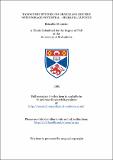Files in this item
Taxonomic studies on Brazilian legumes with forage potential - Sesbania, Lupinus
Item metadata
| dc.contributor.advisor | Gibbs, Peter Edward | |
| dc.contributor.author | Monteiro, Reinaldo | |
| dc.coverage.spatial | 446 p. | en_US |
| dc.date.accessioned | 2018-06-15T15:52:36Z | |
| dc.date.available | 2018-06-15T15:52:36Z | |
| dc.date.issued | 1985 | |
| dc.identifier.uri | https://hdl.handle.net/10023/14135 | |
| dc.description.abstract | The present study consists of a taxonomic revision of the New World species of Sesbania (Papilionoideae, Robinieae) and taxonomic studies on the unifoliolate species of Lupinus (Papilionoideae, Genisteae) in Brazil. The genus Sesbania in the New World is here recognised as comprised of the subgenera Sesbania (with three native and three introduced species), Daubentonia (with five species) and Agati (one species, introduced). As part of the taxonomic revision of Sesbania, a survey on chromosome number and studies on pollen and seed morphology are presented. In an outline treatment of the genus Lupinus in Brazil the problems associated with the ca. 16 multifoliolate species are reviewed. The unifoliolate species have been studied in detail and 13 species are recognised. A taxonomic account of the unifoliolate species with key, descriptions and illustrations and specimen citations is presented. A SEM survey of pollen grains and testa of Lupinus, with particular emphasis on the Brazilian unifoliolate species accompanies this study. | en_US |
| dc.language.iso | en | en_US |
| dc.publisher | University of St Andrews | |
| dc.subject.lcc | QK495.L52M7 | en |
| dc.subject.lcsh | Legumes | en |
| dc.title | Taxonomic studies on Brazilian legumes with forage potential - Sesbania, Lupinus | en_US |
| dc.type | Thesis | en_US |
| dc.contributor.sponsor | Overseas Development Agency | en_US |
| dc.contributor.sponsor | British Council | en_US |
| dc.type.qualificationlevel | Doctoral | en_US |
| dc.type.qualificationname | PhD Doctor of Philosophy | en_US |
| dc.publisher.institution | The University of St Andrews | en_US |
This item appears in the following Collection(s)
Items in the St Andrews Research Repository are protected by copyright, with all rights reserved, unless otherwise indicated.

